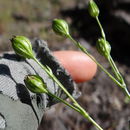Comments
(
Inglês
)
fornecido por eFloras
The six varieties and forms of Silene antirrhina noted above were named on the basis of stature and flower color, but none appear to be worthy of recognition. The species is very plastic, being greatly affected by moisture, exposure, and nutrients.
- licença
- cc-by-nc-sa-3.0
- direitos autorais
- Missouri Botanical Garden, 4344 Shaw Boulevard, St. Louis, MO, 63110 USA
Description
(
Inglês
)
fornecido por eFloras
Plants annual; taproot slender. Stems erect, simple or branched, slender, to 80 cm, subglabrous to retrorsely puberulent especially proximally, distal internodes frequently glutinous. Leaves 2 per node; blade with margins ciliate toward base, apex acute to obtuse; basal blades oblanceolate, spatulate; cauline narrowly oblanceolate to linear, 1-9 cm × 2-15 mm, scabrous or puberulent, rarely glabrous on both surfaces. Inflorescences cymose, open, branches usually ascending, several- to many-flowered, 1-flowered in depauperate specimens. Flowers: mature calyx prominently 10-veined, campanulate to ovate, 5-9 × 3-5 mm, margins dentate, glabrous, veins parallel, with pale commissures; lobes usually purple, triangular, acute, ca. 1 mm; petals white, often suffused with dark red, rarely wholly dark red, limb ovate, usually 2-lobed, ca. 2.5 mm, slightly longer than calyx, rarely petals absent, claw narrow, appendages 0.1-0.4 mm; stamens included; styles 3; stigmas included. Capsules equaling calyx, opening by 6 teeth; carpophore less than 1 mm. Seeds dull gray-black, reniform, 0.5-0.8 mm diam., finely papillate. 2n = 24.
- licença
- cc-by-nc-sa-3.0
- direitos autorais
- Missouri Botanical Garden, 4344 Shaw Boulevard, St. Louis, MO, 63110 USA
Distribution
(
Inglês
)
fornecido por eFloras
Alta., B.C., Man., N.B., Ont., Que., Sask.; Ala., Ariz., Ark., Calif., Colo., Conn., Del., D.C., Fla., Ga., Idaho, Ill., Ind., Iowa, Kans., Ky., La., Maine, Md., Mass., Mich., Minn., Miss., Mo., Mont., Nebr., Nev., N.H., N.J., N.Mex., N.Y., N.C., N.Dak., Ohio, Okla., Oreg., Pa., R.I., S.C., S.Dak., Tenn., Tex., Utah, Vt., Va., Wash., W.Va., Wis., Wyo.; Mexico; South America; adventive in Europe.
- licença
- cc-by-nc-sa-3.0
- direitos autorais
- Missouri Botanical Garden, 4344 Shaw Boulevard, St. Louis, MO, 63110 USA
Flowering/Fruiting
(
Inglês
)
fornecido por eFloras
Flowering spring-late summer.
- licença
- cc-by-nc-sa-3.0
- direitos autorais
- Missouri Botanical Garden, 4344 Shaw Boulevard, St. Louis, MO, 63110 USA
Habitat
(
Inglês
)
fornecido por eFloras
Dry, sandy or gravelly places, roadsides, fields, waste places, open woods, often appearing after burning; 0-2300m.
- licença
- cc-by-nc-sa-3.0
- direitos autorais
- Missouri Botanical Garden, 4344 Shaw Boulevard, St. Louis, MO, 63110 USA
Synonym
(
Inglês
)
fornecido por eFloras
Silene antirrhina var. confinis Fernald; S. antirrhina var. depauperata Rydberg; S. antirrhina var. divaricata B. L. Robinson; S. antirrhina var. laevigata Engelmann & A. Gray; S. antirrhina var. subglaber Engelmann & A. Gray; S. antirrhina var. vaccarifolia Rydberg
- licença
- cc-by-nc-sa-3.0
- direitos autorais
- Missouri Botanical Garden, 4344 Shaw Boulevard, St. Louis, MO, 63110 USA
Silene antirrhina
(
Inglês
)
fornecido por wikipedia EN
Silene antirrhina is a species of flowering plant in the family Caryophyllaceae known by the common names sleepy silene[1] and sleepy catchfly.[2] It is native to the Americas, where it is widespread throughout North America and parts of South America. It is known in Europe as an introduced species.
It can be found in a wide range of habitat types, including disturbed and recently burned areas. It is sometimes weedy.
Description
Silene antirrhina is quite variable in appearance, its morphology depending on several environmental factors, such as moisture level and available nutrients.[3] In general it is an annual herb growing erect to a maximum height near 80 centimeters (31 in).
The slender stem grows from a taproot and branches near the top. There are dark-colored internodes on the stem, the upper ones often glandular and sticky in texture. Insects become trapped in the sticky patches on this protocarnivorous plant, but it does not obtain any nutrients from them.[4] The lance-shaped leaves are up to 6 centimeters (2.4 in) long near the base of the stem, and are smaller and narrower farther up.
The flower is enveloped in an inflated ovate calyx of fused sepals with ten veins. The calyx is open at the top, often revealing five double-lobed petals in shades of pink, red, or purple to white; the petals are sometimes absent.
References

- licença
- cc-by-sa-3.0
- direitos autorais
- Wikipedia authors and editors
Silene antirrhina: Brief Summary
(
Inglês
)
fornecido por wikipedia EN
Silene antirrhina is a species of flowering plant in the family Caryophyllaceae known by the common names sleepy silene and sleepy catchfly. It is native to the Americas, where it is widespread throughout North America and parts of South America. It is known in Europe as an introduced species.
It can be found in a wide range of habitat types, including disturbed and recently burned areas. It is sometimes weedy.
- licença
- cc-by-sa-3.0
- direitos autorais
- Wikipedia authors and editors
Silene antirrhina
(
Vietnamita
)
fornecido por wikipedia VI
- licença
- cc-by-sa-3.0
- direitos autorais
- Wikipedia tác giả và biên tập viên
Silene antirrhina: Brief Summary
(
Vietnamita
)
fornecido por wikipedia VI
Silene antirrhina là loài thực vật có hoa thuộc họ Cẩm chướng. Loài này được L. miêu tả khoa học đầu tiên năm 1753.
- licença
- cc-by-sa-3.0
- direitos autorais
- Wikipedia tác giả và biên tập viên

